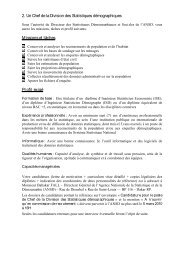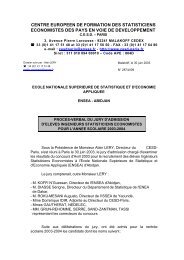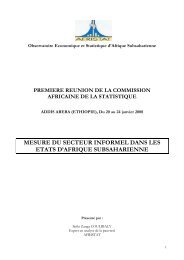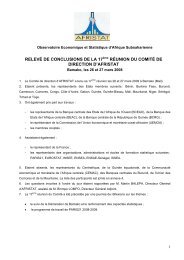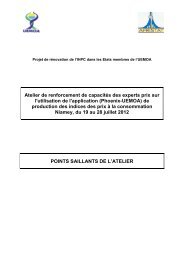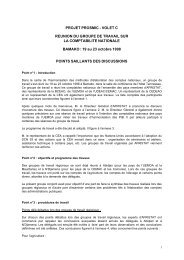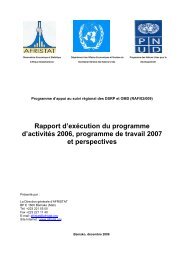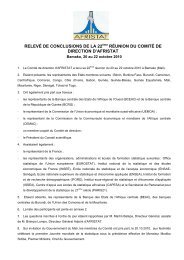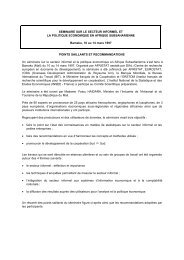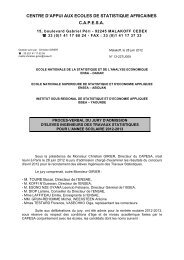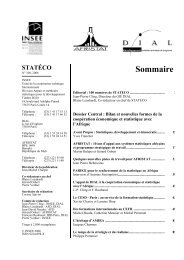Global Purchasing Power Parities and Real Expenditures - Afristat
Global Purchasing Power Parities and Real Expenditures - Afristat
Global Purchasing Power Parities and Real Expenditures - Afristat
You also want an ePaper? Increase the reach of your titles
YUMPU automatically turns print PDFs into web optimized ePapers that Google loves.
Methodology: Calculating PPPs 161Table 5Number of products priced by region <strong>and</strong> for the ringcomparisonCategory africa Asia-Pacific CIS OECD–Eurostat Latin America W. Asia RingFood <strong>and</strong> nonalcoholic beverages 356 223 198 422 147 353 281Alcoholic beverages <strong>and</strong> tobacco 41 19 20 72 8 21 30Clothing <strong>and</strong> footwear 128 78 104 319 136 162 132Housing <strong>and</strong> utilities 21 17 22 64 18 12 35Furnishings <strong>and</strong> household equipment 95 85 91 460 77 83 124Health 144 112 75 244 51 69 162Transportation 55 65 47 365 33 29 96Communication 19 19 16 81 8 12 28Recreation <strong>and</strong> culture 49 70 79 336 54 59 96Education 7 7 7 5 10 11 7Restaurants <strong>and</strong> hotels 51 25 45 117 14 20 60Miscellaneous goods <strong>and</strong> services 34 56 36 136 22 31 44Total consumption 1,000 776 740 2,621 578 862 1,095General government 50 50 50 50 50Construction 34 34 34 34 34Equipment 108 108 108 108 108Source: ICP <strong>Global</strong> Office.phase. Even though the final product specifications differedfrom one region to another, the regional SPDs were used toidentify those products that were most likely to be comparablebetween regions. In consultation with the ring countries,the global office prepared the final product list for thehousehold consumption products.As was the case with the regional comparisons, productsthat were not covered by this process were housing, governmentconsumption, health, <strong>and</strong> capital goods. <strong>Global</strong>specifications were prepared for these items <strong>and</strong> priced byall countries, except those in the CIS, OECD, <strong>and</strong> Eurostatregions. That meant that the same data were used for boththe regional <strong>and</strong> ring comparisons for Africa, Asia-Pacific,South America, <strong>and</strong> Western Asia. Ring countries in theEurostat-OECD region priced the ICP global specificationsfor the ring comparison.The number of products specified for the ring comparison<strong>and</strong> the number actually priced in each region areshown in table 5. (A more detailed description of the ringmethodology can be found in chapters 13–15 of the ICP2003–2006 H<strong>and</strong>book.)The following steps were used to compute the globalPPPs:mmmBasic-heading ring prices for each ring countrywithin a region were converted to a regional priceusing the regional PPPs. This resulted in five sets ofregional prices in each basic heading.The CPD method was used to compute five betweenregionPPPs for each basic heading.The between-region PPPs served as scale factors thatconverted each country’s regional PPPs to global,basic-heading PPPs referenced to the U.S. dollar.



